Introduction: Why Safety Should Come First
Online dating has become one of the most common ways people meet potential partners, and Facebook Dating is no exception. With millions of users worldwide, the feature offers a convenient way to connect with singles nearby who share your interests. But as exciting as it may be to match and chat, meeting someone in real life for the first time carries certain risks.
Unfortunately, not every profile represents someone’s true intentions. While many people genuinely use Facebook Dating to find meaningful connections, others may misuse the platform for dishonest or harmful purposes. That’s why your safety should always come first.
In this comprehensive guide, I’ll share practical safety tips for meeting someone from Facebook Dating, drawn from over a decade of experience studying online relationship trends, security best practices, and real-world dating experiences. Whether you’re new to online dating or already experienced, these strategies will help you feel confident, secure, and prepared when you decide to meet someone in person.
1. Before You Meet: Online Safety Starts Early
Meeting safely begins long before you ever step outside your door. The way you handle your conversations and interactions online sets the tone for your safety offline.

Verify Their Profile Information
Don’t just take someone’s profile at face value. Use these quick checks:
-
Look for consistency in their photos (do they look like the same person across all images?).
-
Check if their profile has mutual friends (though not always reliable, it can sometimes add credibility).
-
Pay attention to how they talk — scammers often avoid details or give vague answers.
Use Facebook Dating Chat, Not Your Personal Messenger (At First)
While Facebook Dating does integrate with Messenger once you match, keep your initial conversations within the app. Avoid sharing your phone number, email, or other personal accounts until you feel comfortable.
Look for Red Flags Early
Some signs that you should reconsider meeting someone include:
-
They avoid video calls.
-
They rush into intense feelings or declarations of love.
-
They ask for money, favors, or financial help.
-
Their stories are inconsistent or don’t add up.
If you spot these, trust your instincts. It’s better to end communication than to take risks.
2. Set the Foundation with Communication
Before you meet someone from Facebook Dating, establish clear boundaries and communication practices.
Insist on a Video Call First
A short video chat is one of the best ways to verify that the person is who they claim to be. It reduces the risk of catfishing and gives you a feel for their mannerisms.
Talk About Safety Preferences
Bring up the idea of meeting in public or sharing plans with friends. A genuine person will understand and respect your caution. If they dismiss or mock your safety measures, that’s a major warning sign.
Keep Conversations Balanced
Healthy conversations feel natural and two-sided. If you find yourself constantly answering questions while they reveal very little, reconsider meeting them.

3. Planning the First Meeting
Now that you feel comfortable enough to meet in person, planning becomes key to staying safe.
Choose a Public Location
Always meet in a public place like a café, restaurant, or park with plenty of people around. Avoid private spaces, cars, or their home for the first few dates.
Daytime Meetings Are Safer
Plan to meet during the day or early evening. Well-lit hours reduce risks and give you more flexibility to leave if needed.
Arrange Your Own Transportation
Never let someone you just met pick you up at your home. Use your own car, public transit, or a ride-share app. This way, you control when you arrive and when you leave.
Share Your Plans with a Trusted Friend
Tell a friend or family member:
-
Who you’re meeting.
-
Where you’re going.
-
What time you expect to return.
Even better, share your live location via Messenger, WhatsApp, or a similar app so someone can check in if needed.
4. During the Date: Staying Safe in Real Time
The first meeting should be about enjoying the moment while keeping safety a top priority.
Keep Personal Belongings Secure
Keep your phone, wallet, and keys close to you at all times. Avoid leaving your drink unattended, as drink tampering is a real concern.
Stay Aware of Your Surroundings
It’s easy to get caught up in conversation, but keep an eye on your environment. Notice exits, people nearby, and any behavior that feels off.
Watch for Controlling Behavior
Pay attention to how your date reacts to boundaries:
-
Do they pressure you to go somewhere private?
-
Do they seem upset if you don’t want to order another drink?
-
Do they insist on paying in a way that makes you uncomfortable?
These may be early indicators of controlling tendencies.
Have a Backup Plan
Arrange a simple signal with a friend (like a text emoji) if you want them to call and give you an excuse to leave. Trust your gut — if something feels wrong, don’t second-guess yourself.
5. Protecting Your Privacy
Privacy is one of the most overlooked parts of dating safety.
Don’t Overshare Too Soon
Details like your home address, workplace, daily routine, or family connections should stay private until you’ve built trust over time.
Use Social Media Carefully
Connecting on Facebook or Instagram right away may reveal more than you intend. Wait until you’re sure about the person before opening up your full social media presence.
Limit Location Sharing
While sharing live location with a trusted friend is good, avoid enabling it for your date until much later in the relationship.
6. Handling Red Flags During or After a Meeting
Sometimes, warning signs only become clear once you’ve met in person.
Recognize Manipulative Behavior
If your date tries to guilt-trip you into staying longer, spending money, or ignoring your comfort, that’s a red flag.
Watch for Aggressive or Impatient Behavior
Someone who gets angry when you say “no” or set a boundary is showing their true colors.
Don’t Hesitate to Leave Early
Leaving a date doesn’t mean you’re rude — it means you’re protecting yourself. Excuse yourself politely, and prioritize your safety over their feelings.
7. After the Meeting: Reviewing and Reflecting
After you meet someone from Facebook Dating, take time to reflect.
Ask Yourself These Questions:
-
Did I feel comfortable throughout the date?
-
Did they respect my boundaries?
-
Were their actions consistent with what they said online?
If the answer to any of these feels uneasy, you may want to stop pursuing further meetings.
Trust Your Gut
Your instincts are one of the most powerful safety tools you have. If something feels off, it probably is.
Report Suspicious Behavior
Facebook Dating allows you to block or report users directly from the app. If you encountered harassment, threats, or suspicious activity, take action to protect yourself and others.
8. Safety for Long-Term Dating Through Facebook
If things go well and you continue dating, safety doesn’t stop at the first meeting.
Gradually Build Trust
Introduce personal details slowly. Meet in different settings before visiting private spaces.
Keep Financial Boundaries
Never send money or share sensitive information like bank details. Romance scams are unfortunately common online.
Involve Your Social Circle
Introduce your new partner to friends or family once you’re comfortable. Outside perspectives can help you see things more clearly.
9. Special Considerations for Women, Men, and LGBTQ+ Users
While safety principles apply to everyone, certain groups may face unique challenges.
Women
Women statistically experience higher risks of harassment or unsafe situations in dating. Trust your instincts strongly, and don’t feel pressured to be “polite” if you feel uncomfortable.
Men
Men sometimes overlook safety because they assume they’re not targets. But scams, catfishing, and even physical danger can affect men too. Take precautions seriously.
LGBTQ+ Users
In some regions, LGBTQ+ users face risks related to discrimination or targeting. Use discretion when revealing your identity, and prioritize safe meeting spaces.
10. Real-Life Examples: When Safety Works — and When It Doesn’t
Example 1: Trusting Instincts Saves the Day
Sarah matched with someone who seemed charming. But before meeting, she noticed he refused video calls and avoided specifics about his life. She decided not to meet — later, she discovered through a mutual friend that he was using fake photos. Her caution saved her from potential harm.
Example 2: Ignoring Red Flags Leads to Trouble
Mark met someone quickly without much background checking. On the first date, his date pressured him into lending money for a “family emergency.” When Mark refused, the person became hostile and threatened him. Mark cut contact, but only after enduring a stressful and unsafe situation.
11. Facebook’s Built-In Safety Features
Facebook Dating offers tools that you should take advantage of:
-
Block and Report: Stop contact immediately if someone is inappropriate.
-
Safety Notices: Facebook sometimes flags suspicious accounts.
-
Privacy Settings: You can control who sees your dating profile separate from your main Facebook account.
Using these features makes your experience safer from the start.
Conclusion: Stay Safe and Enjoy the Journey
Meeting someone from Facebook Dating can be the start of a wonderful relationship, but your well-being must always come first. From verifying profiles and planning safe first dates to protecting your privacy and trusting your instincts, each step helps you stay in control.
Remember:
-
Safety begins online with careful communication.
-
Public, planned, and transparent first meetings are best.
-
Red flags should never be ignored.
-
Your privacy and boundaries matter.
By practicing these safety tips, you’ll be better equipped to focus on what truly matters — building genuine connections and enjoying the exciting journey of finding love.

